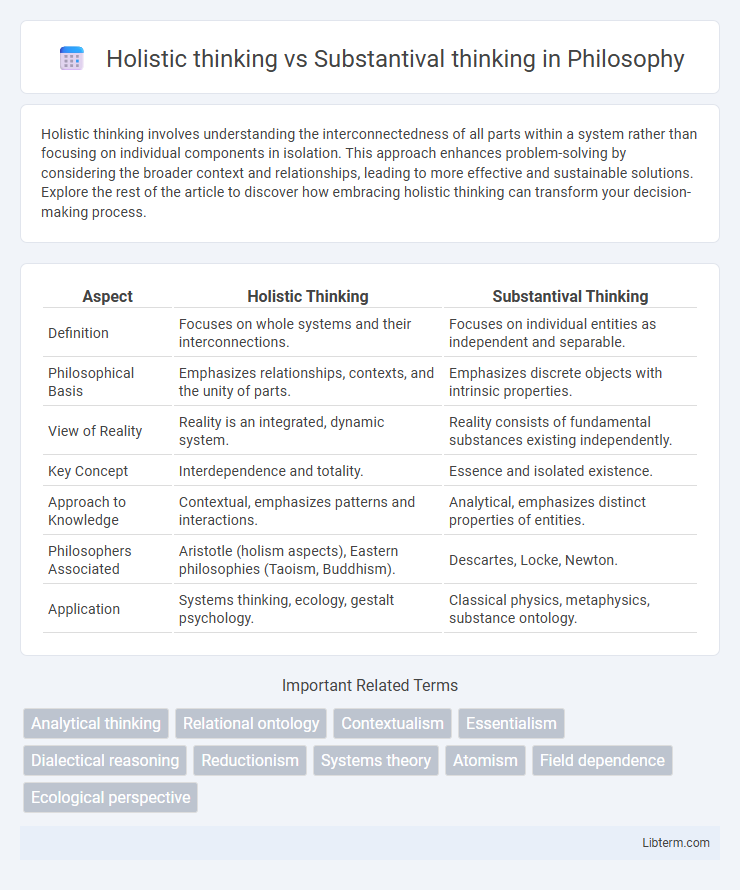Holistic thinking involves understanding the interconnectedness of all parts within a system rather than focusing on individual components in isolation. This approach enhances problem-solving by considering the broader context and relationships, leading to more effective and sustainable solutions. Explore the rest of the article to discover how embracing holistic thinking can transform your decision-making process.
Table of Comparison
| Aspect | Holistic Thinking | Substantival Thinking |
|---|---|---|
| Definition | Focuses on whole systems and their interconnections. | Focuses on individual entities as independent and separable. |
| Philosophical Basis | Emphasizes relationships, contexts, and the unity of parts. | Emphasizes discrete objects with intrinsic properties. |
| View of Reality | Reality is an integrated, dynamic system. | Reality consists of fundamental substances existing independently. |
| Key Concept | Interdependence and totality. | Essence and isolated existence. |
| Approach to Knowledge | Contextual, emphasizes patterns and interactions. | Analytical, emphasizes distinct properties of entities. |
| Philosophers Associated | Aristotle (holism aspects), Eastern philosophies (Taoism, Buddhism). | Descartes, Locke, Newton. |
| Application | Systems thinking, ecology, gestalt psychology. | Classical physics, metaphysics, substance ontology. |
Understanding Holistic Thinking
Holistic thinking emphasizes perceiving systems as integrated wholes rather than isolated parts, recognizing interconnectedness and context in shaping behavior and outcomes. It fosters a comprehensive understanding by considering relationships, patterns, and the dynamic nature of components within a larger system. This approach contrasts with substantival thinking, which isolates entities and analyzes them independently, often missing systemic influences and emergent properties.
Defining Substantival Thinking
Substantival thinking categorizes reality into isolated, independent entities, emphasizing separation over connection. This cognitive approach treats objects and concepts as discrete units with fixed boundaries, often leading to a fragmented understanding of complex systems. Substantival thinking contrasts with holistic thinking by prioritizing reductionism and individual components rather than the interrelationships and dynamic interactions within a whole.
Core Principles of Holistic Thinking
Holistic thinking emphasizes understanding systems as integrated wholes, focusing on relationships, context, and the dynamic interplay between components rather than isolating individual parts. Core principles include recognizing interdependence, embracing complexity, and valuing multiple perspectives to achieve comprehensive insight. This approach contrasts substantival thinking, which analyzes entities independently, often ignoring the broader system and contextual factors shaping them.
Core Principles of Substantival Thinking
Substantival thinking centers on analyzing entities as independent, discrete units with fixed attributes, emphasizing their individual properties over contextual relationships. This approach prioritizes clear, measurable characteristics, often categorizing elements based on inherent substance rather than interactions or system dynamics. Core principles include reductionism, where complex phenomena are broken down into simpler components, and the belief in objective, stable identities irrespective of environmental factors.
Historical Origins of Both Approaches
Holistic thinking originates from ancient Eastern philosophies such as Taoism and Confucianism, emphasizing interconnectedness and the dynamic relationships within systems. Substantival thinking, rooted in Western thought since Aristotle and further developed during the Scientific Revolution, focuses on discrete entities with inherent properties independent of context. These historical origins shaped contrasting worldviews, with holistic perspectives valuing the whole and relations, and substantival approaches prioritizing individual components and their intrinsic nature.
Key Differences between Holistic and Substantival Thinking
Holistic thinking emphasizes understanding systems as interconnected wholes, focusing on relationships and the context surrounding elements, while substantival thinking isolates individual components and examines them independently. Key differences include the approach to causality, where holistic thinking sees causes as interdependent and dynamic, whereas substantival thinking treats causes as linear and discrete. Holistic thinking is often applied in complex systems analysis, ecological studies, and social sciences, contrasting with substantival thinking's utility in reductionist scientific methods.
Applications in Modern Problem-Solving
Holistic thinking emphasizes the interconnectedness of elements within a system, leading to solutions that consider broader contexts and long-term impacts in fields like environmental management and organizational strategy. Substantival thinking isolates individual components, optimizing specific variables for targeted outcomes, common in engineering, data analysis, and technical troubleshooting. Applying holistic approaches fosters innovation in complex, adaptive systems, while substantival methods excel in precise, controlled problem-solving scenarios.
Holistic vs Substantival Thinking in Education
Holistic thinking in education emphasizes interconnectedness, integrating multiple disciplines and real-world contexts to foster critical thinking and creativity. Substantival thinking, by contrast, focuses on discrete facts and isolated concepts, promoting rote memorization and compartmentalized knowledge. Embracing holistic approaches leads to deeper understanding and adaptive learning, preparing students for complex problem-solving in dynamic environments.
Cultural Perspectives on Thinking Styles
Holistic thinking, prevalent in East Asian cultures, emphasizes context, relationships, and the interconnectedness of objects and events, contrasting with substantival thinking common in Western cultures that focuses on discrete objects and their inherent attributes. Research in cross-cultural psychology reveals that holistic thinkers often perceive contradictions and change as natural, whereas substantival thinkers prioritize formal logic and stable categories. These differing cognitive styles influence communication, problem-solving, and decision-making processes, reflecting deep-seated cultural values and worldviews.
Integrating Both Approaches for Balanced Reasoning
Integrating holistic thinking and substantival thinking fosters balanced reasoning by combining the big-picture perspective with detailed analysis, enhancing problem-solving accuracy. Holistic thinking emphasizes context and relationships within systems, while substantival thinking focuses on discrete facts and individual components, making their integration essential for comprehensive understanding. Utilizing both approaches enables nuanced decision-making that accounts for complexity without losing sight of crucial specifics.
Holistic thinking Infographic

 libterm.com
libterm.com